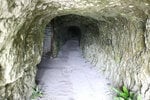Hello guys.
First time poster here not a massively interesting one but I was passing through the area so thought it was worth a look. Its taken me ages to get this posted as the whole reason I visited this site was to test out some 35mm film which I didn't get developed for while.
The History: Designed to work in conjunction with the UGHQ underneath Fort Southwick, construction of this small radio bunker started in May of 1942, long in preparation for the D-Day operations.
The large antennas required to send messages across to Normandy were huge targets for German bombings, presenting a risk of the UGHQ being collapsed in bombing raids, hence the antennas were placed along the cliff atop of Paulsgrove chalk pit, directing any potential bombing runs away from the fort. The radio bunker itself was dug directly under the antennas to make the wiring process easy, and to keep the cable from losing too much power. This radio bunker and Fort Southwick were linked by secure COMMS lines, this radio bunker essentially being the UGHQ's ears during the critical hours of D-Day. There is quite a bit of good info on this link. http://www.portsdown-tunnels.org.uk/paulsgrove/chalkpit/radio_station_p1.html
The Explore: Not the essayist place to find and get into or find. The entrance is a small hole 20ft up a slippery chalk cliff that I wasn't well prepared for. My exit from the place was more a controlled fall than anything. I went in through what was originally the escape portal which after a short crawl opens into a walk able passage. Inside there are two main chambers connected by some stairs. Everything has been striped out but there's plenty of tags (some still wet), beer cans, whippets and the remains of some fires.
The view down the main entrance.

A side chamber.

The first large chamber.

The connecting stairs.

The second chamber.



Looking in from the escape tunnel crawl.

The view out the escape tunnel.

For the last few photos I used my 35mm Olympus om 10 leaded with some Ilford Ortho+.



No idea what went wrong here but I kinda like it.


Thanks for reading.
First time poster here not a massively interesting one but I was passing through the area so thought it was worth a look. Its taken me ages to get this posted as the whole reason I visited this site was to test out some 35mm film which I didn't get developed for while.
The History: Designed to work in conjunction with the UGHQ underneath Fort Southwick, construction of this small radio bunker started in May of 1942, long in preparation for the D-Day operations.
The large antennas required to send messages across to Normandy were huge targets for German bombings, presenting a risk of the UGHQ being collapsed in bombing raids, hence the antennas were placed along the cliff atop of Paulsgrove chalk pit, directing any potential bombing runs away from the fort. The radio bunker itself was dug directly under the antennas to make the wiring process easy, and to keep the cable from losing too much power. This radio bunker and Fort Southwick were linked by secure COMMS lines, this radio bunker essentially being the UGHQ's ears during the critical hours of D-Day. There is quite a bit of good info on this link. http://www.portsdown-tunnels.org.uk/paulsgrove/chalkpit/radio_station_p1.html
The Explore: Not the essayist place to find and get into or find. The entrance is a small hole 20ft up a slippery chalk cliff that I wasn't well prepared for. My exit from the place was more a controlled fall than anything. I went in through what was originally the escape portal which after a short crawl opens into a walk able passage. Inside there are two main chambers connected by some stairs. Everything has been striped out but there's plenty of tags (some still wet), beer cans, whippets and the remains of some fires.
The view down the main entrance.
A side chamber.
The first large chamber.
The connecting stairs.
The second chamber.
Looking in from the escape tunnel crawl.
The view out the escape tunnel.
For the last few photos I used my 35mm Olympus om 10 leaded with some Ilford Ortho+.
No idea what went wrong here but I kinda like it.
Thanks for reading.


